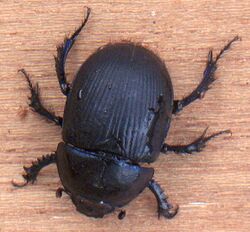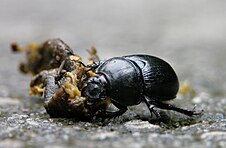Biology:Geotrupes stercorarius
| Geotrupes stercorarius | |
|---|---|

| |
| Scientific classification | |
| Domain: | Eukaryota |
| Kingdom: | Animalia |
| Phylum: | Arthropoda |
| Class: | Insecta |
| Order: | Coleoptera |
| Family: | Geotrupidae |
| Genus: | Geotrupes |
| Species: | G. stercorarius
|
| Binomial name | |
| Geotrupes stercorarius | |
Geotrupes stercorarius is a species of earth-boring dung beetle. Its common name is the dor beetle, or, the dumbledore,[1] and is common throughout Europe.[2]
The beetle is up to 2.5 cm (1 in) long. The whole beetle is weakly lustrous and darkly colored, sometimes with a bluish sheen. The body shape is very compact and arched toward the top. On each elytron seven long rows of points are just visible. The head is clearly forward, and similar to a shovel in shape. The antennae are short and thicken into fans at the ends. On each leg there are numerous spikes.
The beetle is coprophagous, feeding on the droppings of herbivorous animals. They show a preference for horse dung but are not uncommon in cattle dung and have also been recorded from other species as well as at rotting fungi. Adults appear a little later in the year than G. spiniger, generally from April or May, and might occur wherever suitable host material is abundant; cattle pasture but also woodland, moorland and hillsides, they are mostly crepuscular or nocturnal and may be seen in flight, often around cattle as they lie in fields, or attracted to light in large numbers. Mating occurs in the spring and both sexes participate in digging a vertical burrow directly beneath the host material, this may be up to 50 cm (20 in) deep, depending on the substrate, and when finished the female will begin at the base and dig a series of horizontal brood chambers off the main burrow, each will be provisioned with dung and a single egg before being sealed with soil from the next chamber. Larvae development proceeds through the summer and some will pupate and produce adults in the autumn that will feed and then overwinter in the burrows, while others will remain within the brood chambers and pupate in the spring to produce slightly later adults. Adults fly over pasture etc. on warm spring and summer evenings but they may also fly considerable distances and occur far from apparently suitable habitats, sometimes in gardens or on roadsides, no doubt disorientated by lights, and by late spring most are heavily infested with phoretic mites.[2]
In the evenings, one can observe them closely circle around the animals on the ground. They create a chirping sound with their hind legs.
References
| Wikimedia Commons has media related to Geotrupes stercorarius. |
- ↑ Brown, Joanna Cullen (1998), "Variations on Two Enigmas: Hardy, Elgar and the Muses", Reading Thomas Hardy (London: Palgrave Macmillan UK): pp. 188–208, ISBN 978-1-349-26659-3, http://dx.doi.org/10.1007/978-1-349-26657-9_9, retrieved 2024-01-24
- ↑ 2.0 2.1 "Geotrupes stercorarius" (in en). https://www.ukbeetles.co.uk/geotrupes-stercorarius.

Wikimedia Commons has media related to Geotrupes stercorarius.  This article incorporates text available under the CC BY 4.0 license.
This article incorporates text available under the CC BY 4.0 license.
- Harde, Severa: Der Kosmos Käferführer, Die mitteleuropäischen Käfer, Stuttgart: Franckh-Kosmos Verlags-GmbH & Co, 2000, ISBN:3-440-06959-1
- Jiři Zahradnik, Irmgard Jung, Dieter Jung et al.: Käfer Mittel- und Nordwesteuropas, Berlin: Parey, 1985, ISBN:3-490-27118-1
Wikidata ☰ Q21190 entry
 |


